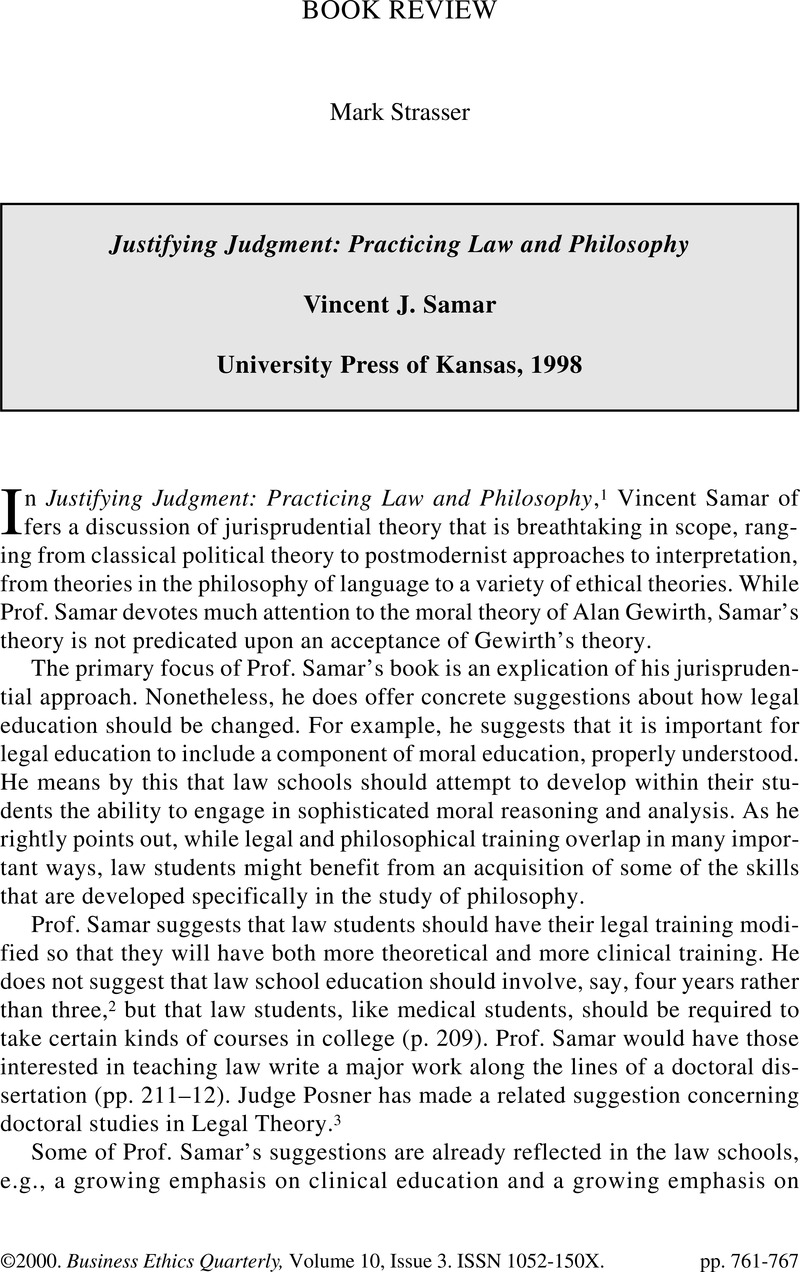No CrossRef data available.
Published online by Cambridge University Press: 23 January 2015

1 Vincent J. Samar, Justifying Judgment: Practicing Law and Philosophy (Lawrence: University Press of Kansas, 1998).
2 Were there to be a change in the number of years required for a legal education, such a change would more likely involve a reduction than an increase. Cf. Richard A. Posner, “The Deprofessionalization of Legal Teaching and Scholarship,” Michigan Law Review 91 (1993): 1921, 1928 (suggesting that students should not be required to attend three years of law school in order to become members of the legal profession).
3 See Richard A Posner, “The Decline of Law as an Autonomous Discipline: 1962–1987,” Harvard Law Review 100 (1987): 761, 779.
4 See Robert MacCrate, Legal Education and Professional Development—An Educational Continuum (St. Paul: West Publishing Co., 1993).
5 See H. L. A. Hart, “Positivism and the Separation of Law and Morals,” Harvard Law Review 17 (1958) 593, 617, 620.
6 See MacPherson v. Buick Motor Co., 111 N.E. 1050, 1051 (N.Y. 1916) (“It is possible to use almost anything in a way that will make it dangerous if defective.”)
7 See Samar, Justifying Judgment, p. 59 (“Although from one point of view an automobile is more like a wagon than a bottle of mislabeled medicine, the court, nevertheless, applied the exception”).
8 See Planned Parenthood of Southeastern Pennsylvania v. Casey, 505 U.S. 833, 980 (1992) (plurality opinion) (Scalia, J., concurring in part and dissenting in part).
9 See Charles Fried, Order and Law: Arguing the Reagan Revolution—A Firsthand Account (New York: Simon and Schuster, 1991), pp. 81–82.
10 388 U.S. 1 (1967) (striking interracial marriage ban).
11 381 U.S. 479 (1965) (striking law precluding married couples from having access to contraception).
12 405 U.S. 438 (1972) (striking law preventing unmarrieds from having access to contraception).
13 410 U.S. 113 (1973) (striking down abortion law).
14 Fried, Order and Law, p. 83.
15 See Bowers v. Hardwick, 478 U.S. 186, 197 (1986) (Burger, C. J. concurring).
16 See Kenneth L. Karst, “Myths of Identity: Individual and Group Portraits of Race and Sexual Orientation,” UCLA Law Review 43 (1995): 263, 294 (characterizing Burger’s appeal to moral teachings as spurious); Astrid A. M. Mattijssen and Charlene L. Smith, “Dutch Treats: The Lessons the U.S. Can Learn from How the Netherlands Protects Lesbians and Gays,” American University Journal of Gender and Law 4 (1996): 303, 315 (discussing Bowers and then commenting: “Relying on such antiquated rhetoric to decide homosexuals’ constitutional rights is as absurd as relying on the moral teachings of the Spanish Inquisition to determine the constitutional rights of Jews.”).
17 517 U.S. 620 (1996).
18 852 P.2d 44 (Haw.) reconsideration granted in part, 875 P.2d 225 (Haw. 1993).